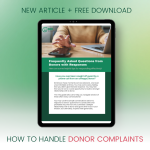Learn the 3 phases of a donor relationship…
Introduced by Lolly Colombo, Chief Client Officer
Make sure you understand how to speak to the heart of your donors for long-term retention of their support. This guest article, generously shared with our audience by Dunham + Company, will walk you through the three phases of a donor relationship and how to communicate with them at every crucial step.
When it comes to your organization or ministry, where does the donor journey usually end?
All too often, it ends somewhere in the relationship as a result of poor communication on the part of the organization. Moral of the story? The way you communicate with your donor matters.
To better understand the process, let’s start by diving into the three phases of the donor relationship:
Phase 1: Awareness
Most people assume that the donor journey begins when you acquire a new donor. But similar to a dating relationship, before your first date, you’re building an awareness of that person and learning about them. The same is true in the donor relationship. This is when telling your story in a clear, meaningful way is so very crucial.
If your story seems confusing or isn’t compelling, you’ll lose donors before they’re even on your path.
In addition to ongoing storytelling, social media is a great tool for building awareness and creating a connection. Get your audience engaged on social, then move them into deeper levels of engagement and communication.
Ask yourself… When it comes to my organization, does the donor journey end before it even begins?
Phase 2: Conversion
This phase takes place in the first 12 months after acquiring a donor…
And research shows that if you can increase these donors to a second and third gift within 12 months, you’re increasing the likelihood of a long-term donor relationship with lifetime value.
It’s here that your number one goal should be building the relationship with the donor. Automated emails can be efficient but what else are you doing? Do you make calls? Write notes? How are you differentiating your organization from all the others?
Personalize the experience with names and be sure that when your donor wants to give, the process is straightforward and simple.
Ask yourself… Is it hard to give a gift to my organization? How am I making it easier and more personal?
Phase 3: Retention
Stay on the path with your donor, even when they lapse, then bring them back into the ecosystem effectively with reactivation. Focus on more intense communication strategies that are not just contingent around giving levels, but also the length of time that donor has been in the file.
Losing a donor after 10 years is far more painful to the organization than losing a donor after one gift.
Cultivate your long-time donors with a different level of commitment and sophistication. And again, if your story is flat, you’re not standing out from the rest of the “asks” in their inbox.
Ask yourself… How am I investing in my long-time donors and is my communication effective?
Watch your language
Remember, your donors aren’t here to help you. They’re here to see the outcomes of the ministry with life change. Always make the donor the hero in your communication and allow them to see how their gift is the difference maker.
Perform a quick audit of your communications and pay attention to your language. Do you see a lot of “us” language or “you” language?
“Us” language looks like this: “We provided a thousand meals for needy children!”
“You” language looks like this: “Thanks to your generous gift and heart for children in need, 10 families are no longer hungry this Christmas.”
Be consistent
A relationship can only exist if both parties show up and communicate consistently. The temptation is often to think that you are over-communicating with your donors, but that’s rarely the case according to the data.
So as you approach that further level of engagement, remember that people are looking for more communication, not less. Lean in and be consistent!
Bring your donors along the journey by telling your story in a compelling way, communicate clearly and consistently, and make sure the donor stays in the spotlight.
The donor journey doesn’t have to end before it even begins.




